Hydrangea Pinky Winky - the subtleties of growing
Pinky Winky's panicle hydrangea, even in a single copy, can change the garden beyond recognition. Bred just 10 years ago, the variety has become one of the favorite among gardeners. Due to its high decorativeness and excellent frost-resistant characteristics, the plant has become widespread among designers and summer residents as an element of the exterior of personal plots.
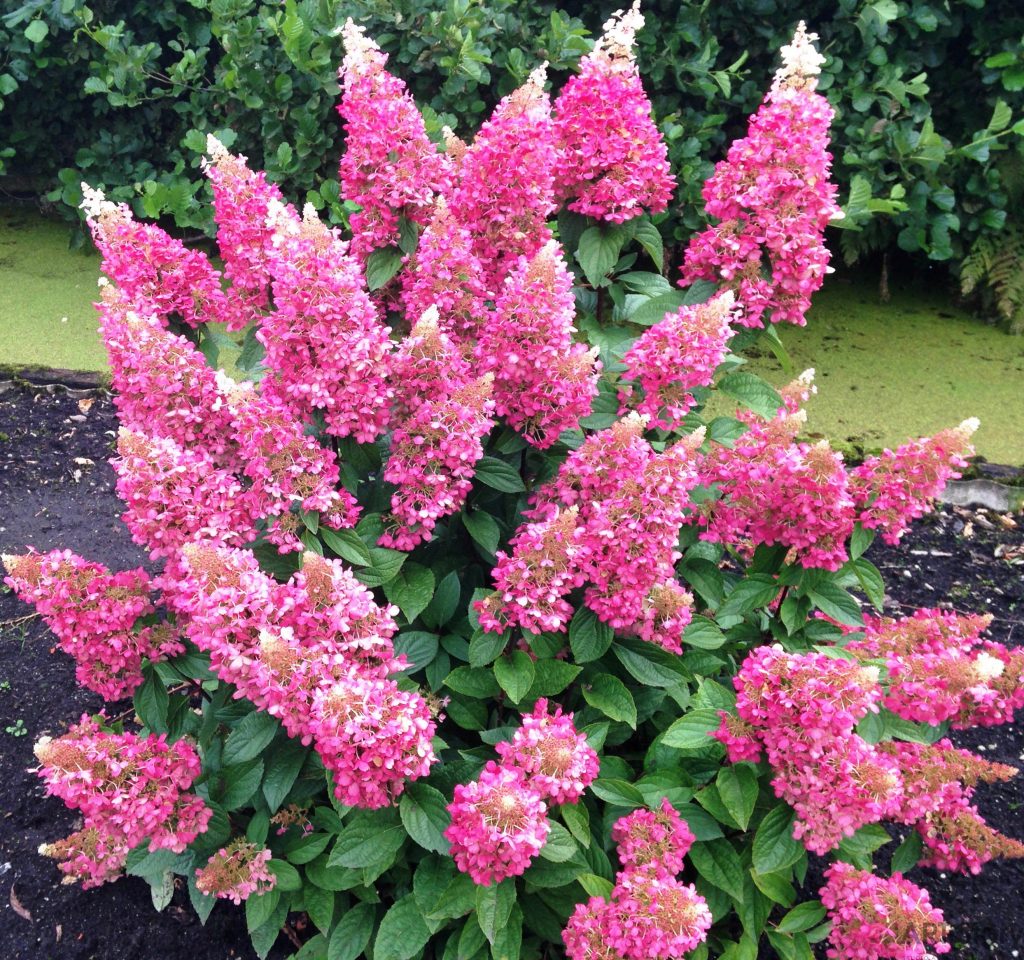
Hydrangea paniculata pinky vinca photo and description
Description of the variety
Botanical name - hydrangea paniculata Pinky Winky.
The variety is a completely compact perennial shrub with treelike branches directed upwards. In height, it can grow up to 2-2.5 m.
The crown is dense, rich emerald color. With the arrival of autumn, the leaf blades acquire an orange-red hue. The plant is actively growing, over the summer it grows by 20-35 cm.
During the flowering period, which falls on almost the entire season, from June to early October, Pinky Winky forms voluminous inflorescences that reach 30 cm in length.
Flowers of small fragrant flowers, first painted white with a beige tint, which turns pink over time. Sometimes a light green shade appears.
According to the description in this phase, the bush is much similar to Vanilla Freyzi, but it has a lower frost resistance. When Vanille Fraise is able to withstand temperatures of minus 35 degrees, the described variety begins to react already at around 25.
Landing features
The plant prefers to grow in one place and is extremely sensitive to transplanting due to the superficial root system.
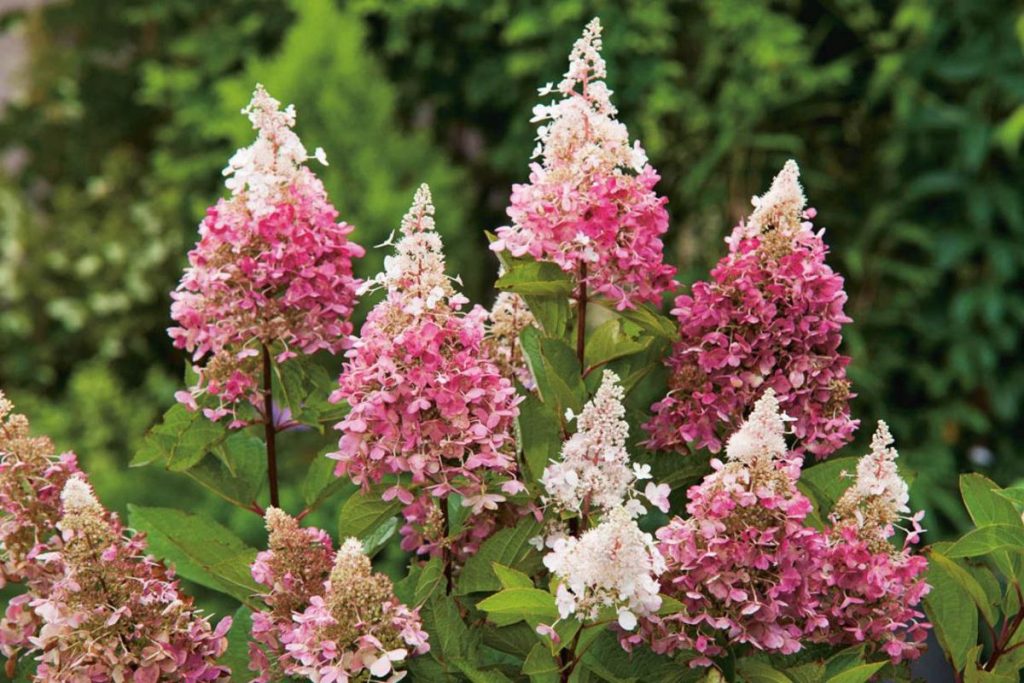
Hydrangea pinky vinky planting and care
Timing
If you choose seedlings with a closed root system for planting, then there are no restrictions on the timing of the procedure.
However, experienced gardeners recommend carrying out the procedure in the spring, so that the plant is guaranteed to take root in the open field before the onset of cold weather.
Seat selection
Pinky winky prefers to grow in a lighted area, but placement in partial shade is also acceptable. With constant exposure to direct sunlight, foliage and inflorescences fade, which leads to a loss of decorativeness.
A lack of light is considered to be the reason for stunted growth and development, as well as a reduction in flowering period and quality.
The optimal location is near trees and buildings with a south or southeast orientation.
An important factor for the comfortable growth of the variety is the soil. The substrate should be rather loose, with a neutral or slightly acidic medium, rich in vermicompost.
Heavy clay soil is not suitable for growing hydrangeas, as well as places with a close occurrence of groundwater. Otherwise, the roots of the plant are at risk of rot.
Optimal soil composition:
- vegetable humus;
- leafy land;
- peat;
- river sand;
- conifers.
If it is necessary to reduce the level of alkali in the substrate, fresh manure, sawdust, ferrous sulfate (50 g per 1 sq. M.) Or citric acid solution (1 tsp. Per 10 l of liquid) are added to it during digging.
Preparation of planting material
When buying seedlings, preference should be given to specimens with a closed root system located in containers - they take root better and are less susceptible to disease. At the same time, attention should be paid to the appearance of the culture - the shoots must be visually healthy.
If a seedling with an open rhizome was purchased, it is treated with a fungicidal preparation before planting, after which the roots are dipped in a clay mash.
Landing technology
Step-by-step description of the planting process:
- They dig a hole with a diameter of 60 cm and a depth of 50 cm. At the same time, they are guided by the dimensions of the root system, the roots should be freely located in the recess.
- Water in the amount of 2-3 buckets.
- In the middle of the hole, set the plant so that the neck remains at the level of the ground surface. If necessary, pre-shorten the roots to the same length. Some gardeners recommend further shortening the shoots by a couple of centimeters.
- Fall asleep with earth. Watering. Mulch.
Care
Watering
Panicle hydrangea loves water, so the topsoil should always remain slightly damp. However, it is worth refraining from frequent abundant watering so as not to provoke waterlogging of the substrate.
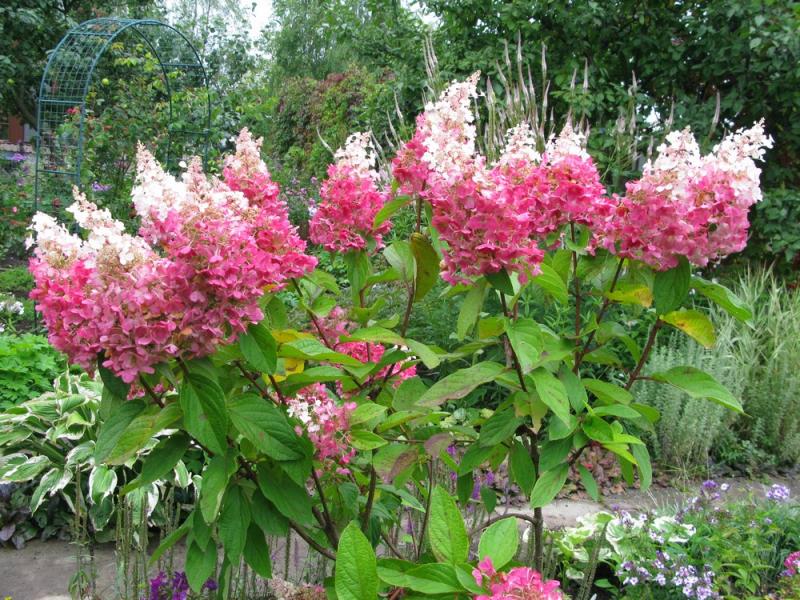
Pinky Vinca Hydrangea Care
The irrigation scheme is chosen taking into account the weather conditions and the season:
- in the summer - 2 times a week;
- in spring - once every 7 days, similarly in autumn in the absence of rain;
With regular precipitation, watering is completely stopped.
Top dressing
The key to active growth and abundant flowering is the timely feeding of the plant, which is carried out, depending on its development phase:
- In the spring, when the first leaves appear, the culture is fertilized with nitrogen-containing preparations. Both mineral complexes and organic matter (infusion of bird droppings or mullein) are used.
- At the initial stage of budding, fertilizers are applied with potassium and phosphorus included in the composition, while the procedure is duplicated every month.
- In the middle of summer, they stop using nitrogen-based products, at the end of August, they completely refuse additional feeding, thereby giving the bush the opportunity to prepare for the upcoming wintering.
Pruning
In order to prevent the loss of decorativeness of the shrub, it is necessary to regularly prune. It is done twice a season:
- In the spring, before the start of sap flow. During the procedure, all branches damaged during the winter, shoots growing inward, protruding outside the stem (in the case of the formation of a standard Hydrangea) segments are cut off. At the same time, young healthy branches are trimmed to 5 points of growth, adults - to a height of 6-8 cm.
- In the fall, 14 days before the final feeding. Manipulations are carried out at a temperature not higher than 10 degrees, removing weakened vegetative processes in the process. Additionally, faded inflorescences are removed.
Preparing for winter
An integral part of Pinky winky care is preparing the crop for winter. It is especially necessary to insulate the plant when grown outdoors in Siberia and the Urals, which are characterized by a harsh climate.
The bush is prepared in several stages:
- After the autumn pruning, all plant residues are removed from the near-stem space.
- Spread a layer of mulch 20 cm thick from sawdust, crushed bark or peat around the base.
- Cover with burlap or any agrotextile. It is also allowed to use artificial materials such as a film, because the culture is not afraid of high humidity during wintering. They are insulated on top with spruce branches.
Reproduction
There are several ways to propagate paniculate hydrangea: seed, layering and cuttings.However, gardeners rarely resort to seed germination due to the fact that the process takes a long time - strong seedlings grow only after 2-3 years.
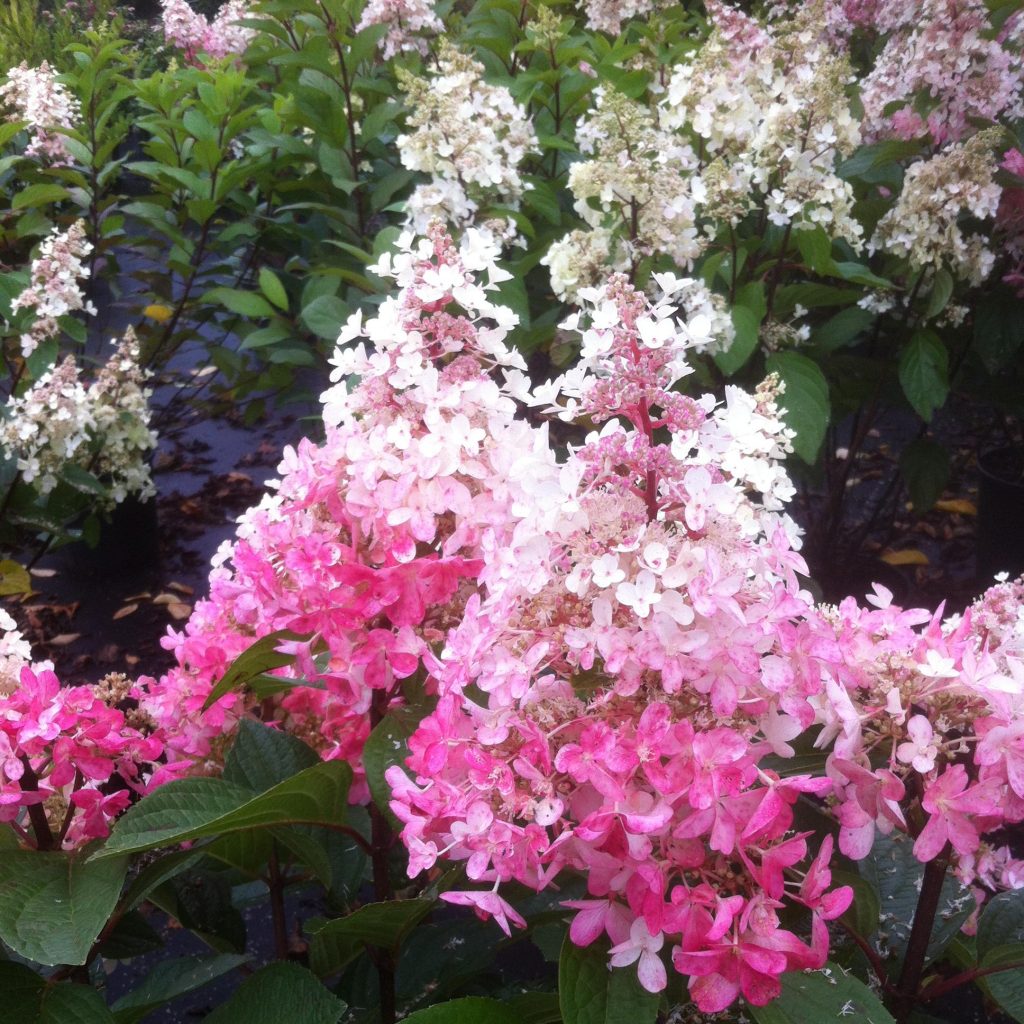
Hydrangea paniculata pinky vinca planting and care in the open field
The most productive method is grafting, which is carried out by following step-by-step instructions:
- At the initial stage of budding, a part of the apical shoot is cut off so that several pairs of leaves are present on the shoot.
- The lower leaf plates are removed, the remaining ones are cut by ½.
- It is kept in a biostimulator for 10-12 hours.
- Close up in moistened ground with the addition of sand 3-5 cm at an angle of 45 degrees.
- A glass jar is placed on top, like a greenhouse, or a film is pulled over the container.
- Before transplanting into open ground, the process is systematically watered and the greenhouse is ventilated.
- In winter, they are kept in a warm room, planted in a flower bed not earlier than next spring.
Another successful option to get young Hydrangea bushes is to use cuttings. To obtain them, a 10 cm depression is dug within the peri-stem circle, to which a lateral branch is bent and sprinkled with earth.
For greater efficiency, the shoot is slightly incised. In the future, they provide the standard care for an adult culture. Layers are separated from the mother plant only for the next year.
Diseases and pests
| Problem | Symptoms | Prophylaxis | Treatment |
| Chlorosis | Deformed buds, yellowing of leaves, twisted edges of leaf plates, crumbling of foliage. | Timely fertilized with organic matter and mineral complexes (universal preparations such as Florist Micro, Uniflorom Micro, Kemira Lux are also suitable), disinfected tools are used for pruning. | At primary signs, spray with iron chelate. It is also allowed to use Agrecol, Ferrilene, Ferovit. With extensive damage, the funds are applied at the root. Alternatively, a potassium nitrate solution is used, with which the substrate is spilled 2-3 times. |
| Powdery mildew | The first manifestations are small specks on the outside of the leaf, gradually increasing in size. As the disease progresses, yellowing of the leaf plates, the appearance of necrotic spots, and early loss of foliage are observed. | Weed in time, remove plant residues, avoid crowding of plantings and thickening of the crown, as well as overdose with nitrogenous compounds. | Traditional methods: whey, ash, iodine, mouthwash. Purchased preparations: Agrolekar, Vectra, Topaz, Alirin, Chistoflor. |
| Gray rot | Grayish dusty coating, first occurs on young shoots. Leaf blades lose their elasticity, change color. | They adhere to the norms of the irrigation regime, excessive moistening of the soil in cloudy weather is not permissible. Regularly loosen the soil, observe the recommended distance between plants. | It is treated with a solution prepared from 10 liters of water, 200 g of ash, 200 g of chalk and 1 tsp. copper sulfate (funds are enough for 3 sq.m.) |
| Root rot | The stem darkens, the plant withers quickly. | They do not allow stagnation of moisture, disinfect the substrate before planting, remove the weeds after weeding, do foliar dressing. | Purchased funds: Trichodermin, Trichophyte, Fundazol, Topaz, copper sulfate, Glyokladin, Maxim, Vitaros. |
| Aphid | Tissues are deformed in places of massive punctures, leaves curl, inflorescences fall off, growth stops. | They eliminate anthills, attract birds to the site, and regularly weed flower beds. | Sprayed during the growing season and at the first sign with systemic drugs: Floristin, Tsvetolux, Calypso, Tanrek. Folk remedies: infusion based on tobacco or hot pepper. |
| Spider mite | Pale thin cobweb, dry leaves, light blotches on the surface | Maintain order on the site, promptly disposing of plant residues. Spray with infusion of garlic (2 crushed heads per 1 liter of liquid, insist for 5 days). | Iskra-Bio, Bitoxibacillin, Kleschevit, Tiovit-Jet, Fufanon-Nova. |
Use in landscape design
There are many variations in the location of Pinky Winky hydrangea in the garden. Basically, the shrub is planted near a fence, garden bench or porch. The culture looks great both individually and in the neighborhood with other decorative flowers, among which preference should be given to shorter ones, defining them in the foreground of the flower bed.
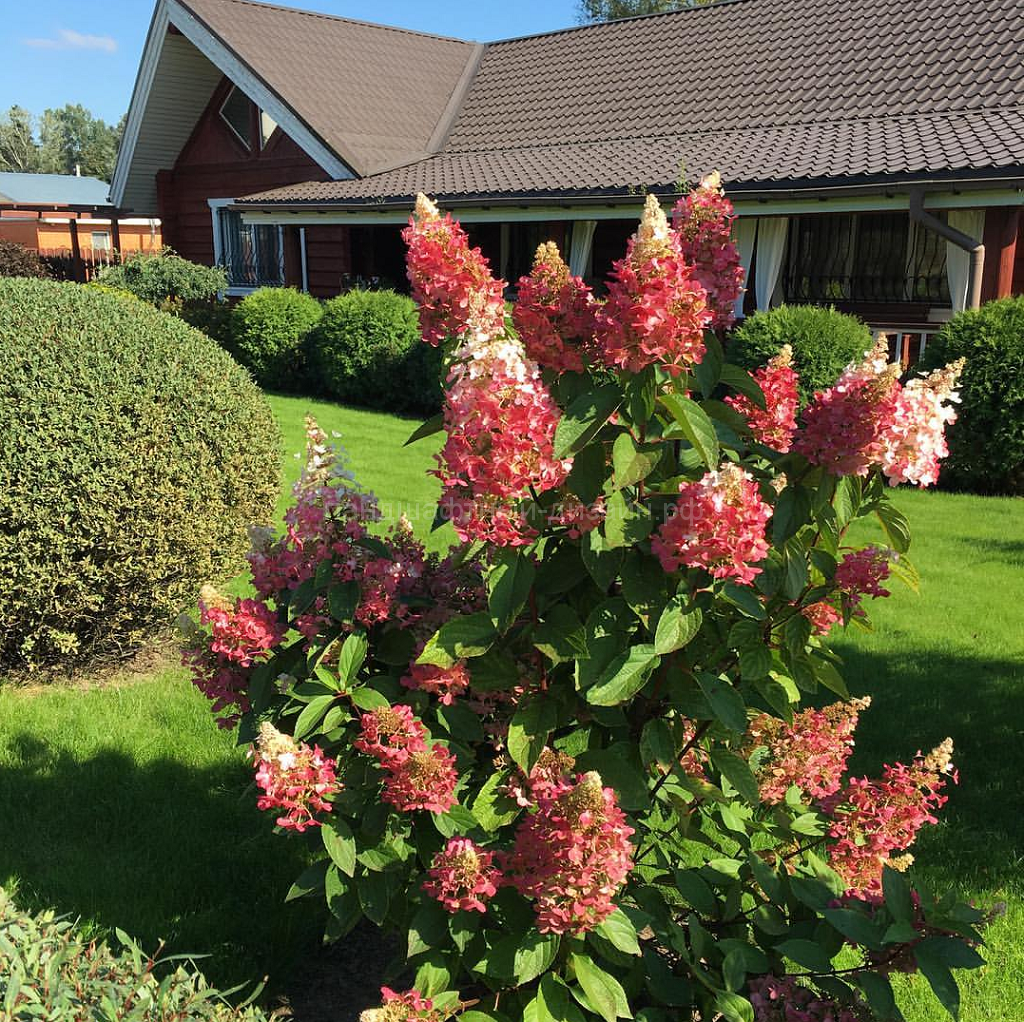
Hydrangea paniculata pinky vinca care
Gardeners reviews
Growers have commented on the ease of growing Pinky Winky. Subject to a small list of agricultural standards, it is possible to maintain the plant in a healthy state. Among the advantages, in addition to good indicators of frost resistance, there is a long flowering period until autumn, subject to regular and correct fertilization.

